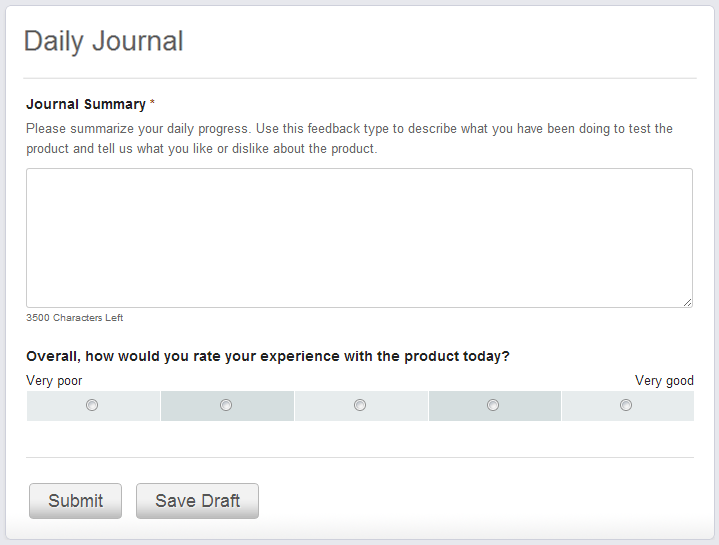How Daily Journals Improve Beta Tests
Daily journals are one of the best ways for you to communicate your user experience to a company during a beta test. Not every beta test uses journals (most of our Betabound tests do), but if they do you’ll be asked to sign in each day and fill out a basic form about your experience with the product that day.
 Typically the form asks you to rate your experience on a 1 to 5 scale, then describe your experience in a short text box. By filling this out each day during the beta test, you’ll be giving the company an invaluable peek into their product’s performance on a day-to-day basis.
Typically the form asks you to rate your experience on a 1 to 5 scale, then describe your experience in a short text box. By filling this out each day during the beta test, you’ll be giving the company an invaluable peek into their product’s performance on a day-to-day basis.
As a tester, you may be thinking that coming up with some sort of new, relevant feedback to report each and every single day might become difficult to do, but in reality the beta manager is simply trying to understand how you use the product, so there’s no “right” thing to talk about. You can discuss the new feature you tried out today, the way you used the product, or just whether the product performed the way you expected.
Daily journals serve a few very important purposes in beta tests:
- They’re an outlet for you to report things you find problematic or interesting that don’t necessarily warrant filling out a bug report or feature request.
- If you’re not the type of person to actively engage in user forum discussions, journals are a great way to make sure your voice is heard.
- They’re a way for companies to test their assumptions about how customers use the product and what they care about.
- They provide you a way to actively participate in the beta test even if you aren’t running into tons of bugs that need to be reported.
Beta managers use the data from daily journals to look for information that might not come out in other types of feedback. Negative journal entries can be used to expose negative user experiences or trends that the development team hadn’t anticipated. Positive journal entries can be invaluable insight for the marketing team to help them improve how they present the product during launch. Either way, the feedback that you submit each day is directly used to better the product that you’re testing.
At the end of the day, when used simultaneously with other forms of feedback (e.g. bug reports, surveys, tasks, and forums), daily journals are a fantastic way for companies to track the progress — or failure — of their product under real-world circumstances. For the testers, it’s a simple way to note your ongoing experiences and impressions of the product in a confidential, uncomplicated way, while keeping you continually involved in the task at hand.
Have you had good/bad experiences with daily journals in previous tests? Is there anything you’ve encountered that we missed in this blog post? Let us know in the comments below.